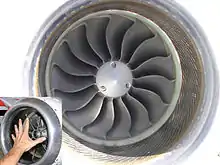Pratt & Whitney Canada PW600
The Pratt & Whitney Canada PW600 series is a family of very small turbofan engines developed by Pratt & Whitney Canada for use in very light jets. Designed with scalability in mind, the engines can produce between 900 lbf (4,000 N) and 3,000 lbf (13,000 N) of take-off thrust.
| PW600 | |
|---|---|
 | |
| PW615F-A with some of its cowlings removed for maintenance | |
| Type | Turbofan |
| National origin | Canada |
| Manufacturer | Pratt & Whitney Canada |
| Major applications | Cessna Citation Mustang Eclipse 400 Eclipse 500 Embraer Phenom 100 |
Design and development
.jpg.webp)

First run of the 2,500 lbf (11,000 N) thrust PW625F demonstrator engine was on 31 October 2001. P&WC began work on the 900 lbf (4 kN) thrust PW610F engine, destined for the Eclipse 500, in 2002. The engine was certified by the Canadian authorities on the 27 July 2006. The first Eclipse 500 aircraft, powered by two PW610Fs, was delivered to a customer on 31 December 2006.
With a 14.5 inch (36.83 cm) diameter fan, the PW610F is one of the smallest turbofans to enter production. Little is known about the engine cycle, although the bypass ratio is believed to be about 1.83.[1] Driven by a single-stage low pressure (LP) turbine, the single stage fan is an advanced snubberless design, with wide chord blades integral with the rotor hub. The layout of the high pressure (HP) compressor is shown in U.S. patent 6,488,469: it has 2 stages, a mixed-flow or diagonal and a centrifugal, and is driven by a single-stage turbine. A reverse-flow combustor and forced mixer/common exhaust are also featured in the design. Dual lane Full Authority Digital Engine Control (FADEC), for smoother, more reliable, operation, is included in the specification. Hispano-Suiza Canada is currently designing and manufacturing the FADEC for this engine.
The larger, 1,460 lbf (6,500 N) thrust, PW615F has a 16-inch (40.64 cm) diameter fan, a bypass ratio of 2.8,[1] and is aimed at the Cessna Citation Mustang. This engine was certified in December 2005, with first deliveries in March 2006. The Mustang aircraft was certified on 8 September 2006, and deliveries began in 2007. This engine was to be used in the Eclipse 400 before it was cancelled, but would have been limited to 1,200 lbf (5,300 N) thrust.
So far, the 1,615 lbf (7,180 N) thrust PW617F, with a 17.6 inch (44.7 cm) diameter fan and bypass ratio of 2.7,[1] is the largest in the family and powers the Embraer Phenom 100. The engine first ran on 29 June 2006, and certification was expected in the 4th quarter of 2007. First delivery of a production model was expected in March 2008.
As of October 15, 2006, fifty PW610Fs and PW615Fs had been delivered by P&WC.
Variants
- PW610F
- PW615F
- PW617F
Applications
Specifications
| PW600 Specifications | ||||||||
|---|---|---|---|---|---|---|---|---|
| PW610F | PW615F | PW617F | PW625F demonstrator | |||||
| Take-off Thrust | 900 pounds-force (4.0 kN) | 1,350 pounds-force (6.0 kN) | 1,615 pounds-force (7.18 kN) | 2,500 pounds-force (11 kN) | ||||
| Flat-rated to: | >ISA+10C | >ISA+10C | >ISA+10C | ? | ||||
| Dry Weight | 259.3 pounds (117.6 kg) | 310 pounds (140 kg) | 380 pounds (170 kg) | ? | ||||
| Length | 45.4 inches (115 cm) | 49.5 inches (126 cm) | 52.6 inches (134 cm) | ? | ||||
| Fan Diameter | 14.5 inches (37 cm) | 16.0 inches (41 cm) | 17.6 inches (45 cm) | 21.8 inches (55 cm) | ||||
References
- The Engine Yearbook 2011, p.143
External links
| Wikimedia Commons has media related to Pratt & Whitney Canada PW600. |